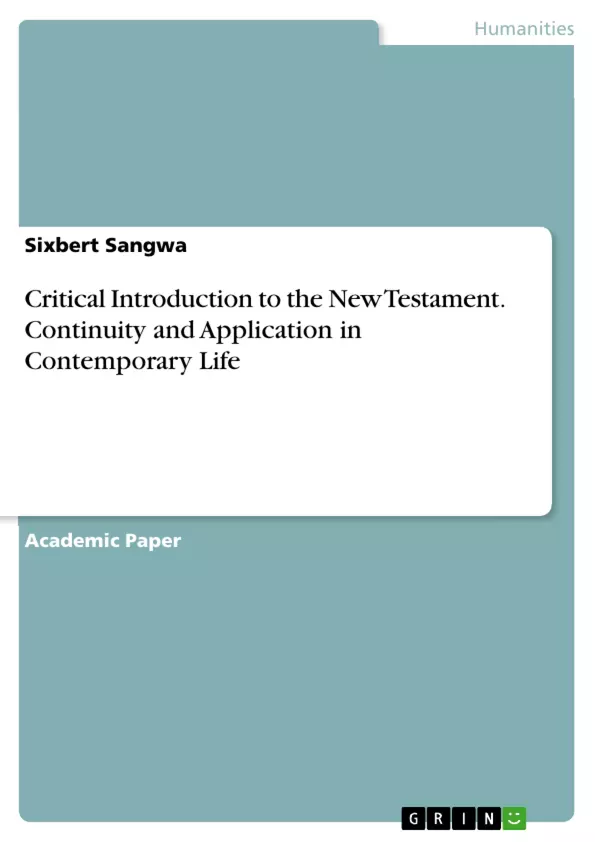This paper discusses the application of the New Testament in contemporary life, with particular attention to how to distinguish the universal and limited or specific application of the texts, as well as to provide a solution that reiterates the meaning and the means of salvation. Christians often read the Bible a few verses or a single chapter at a time. As a result, they may overlook the context and draw unwarranted conclusions.
The critic, on the other hand, looks for the inconsistencies that inevitably throws him on the track. In this paper, the problem of proving the continuity of the New Testament is approached in a way that ties it together by means of a theme or connectivity. Moreover, since the material is now two thousand years old, modern New Testament students are faced with the problem of application, especially how to understand the original intention behind the New Testament for current human history.
However, Jews and Muslims, for their part, are challenged by the question of biblical authority, a problem that confuses many people but presents them with difficulties. In other words, the two overriding questions are what Christians mean by New and Old Testaments and the relationship between them. This problem is compounded by the fact that Jews do not accept the New Testament while Muslims accept both, in theory. However, the common Messianic theme of the two covenants ties them together, so that the evidence points to the meaning of New Testament continuity and integration.
Inhaltsverzeichnis (Table of Contents)
- Continuity and Integration
- The New Testament fulfils the Old Testament
- A promise for a New Testament
- The Presence of Eyewitnesses
- The Universal nature of the New Testament
- The New Testament and Contemporary Life
- Problem statement
- What is there within the New Testament text to suggests it has limited or specific application?
- What is there within the text that suggests it has universal application?
- How may one distinguish between specific and universal application?
- A proposed solution
Zielsetzung und Themenschwerpunkte (Objectives and Key Themes)
This paper examines the continuity of the New Testament with the Old Testament and addresses the challenge of applying its teachings to contemporary life. It seeks to demonstrate how the New Testament fulfills prophecies and promises found in the Old Testament, establishing a cohesive narrative throughout the Bible. The paper also explores the universality and specificity of the New Testament's message, aiming to provide a framework for interpreting and applying its teachings in today's world.
- Continuity of the New Testament with the Old Testament
- Fulfillment of Old Testament prophecies in the New Testament
- Universal and specific applications of the New Testament
- Interpreting and applying the New Testament in contemporary life
- The role of eyewitnesses in the New Testament
Zusammenfassung der Kapitel (Chapter Summaries)
The first section of the paper delves into the concept of continuity and integration between the Old and New Testaments. It argues that the New Testament fulfills the promises and prophecies of the Old Testament, emphasizing the significance of the covenant with Abraham and the promise of a new covenant found in Jeremiah. The section also highlights the role of eyewitnesses in the New Testament, underscoring the importance of their testimony in establishing the validity and reliability of the text.
The second section explores the challenges of applying the New Testament to contemporary life. It examines the issue of specific and universal applications, seeking to clarify how to distinguish between teachings that apply to specific historical contexts and those that have enduring relevance. The section concludes with a proposed solution that aims to provide a framework for interpreting and applying the New Testament in a meaningful way for modern readers.
Schlüsselwörter (Keywords)
This paper examines the relationship between the New Testament and contemporary life, exploring key concepts such as biblical application, biblical interpretation, the universal nature of the Scriptures, and the role of eyewitnesses in establishing the validity of the New Testament. It emphasizes the continuity between the Old and New Testaments, highlighting the fulfillment of Old Testament prophecies in the New Testament. The paper also addresses the challenges of distinguishing between specific and universal applications of the New Testament in a modern context.
- Quote paper
- Dr. Sixbert Sangwa (Author), 2020, Critical Introduction to the New Testament. Continuity and Application in Contemporary Life, Munich, GRIN Verlag, https://www.grin.com/document/1020980



